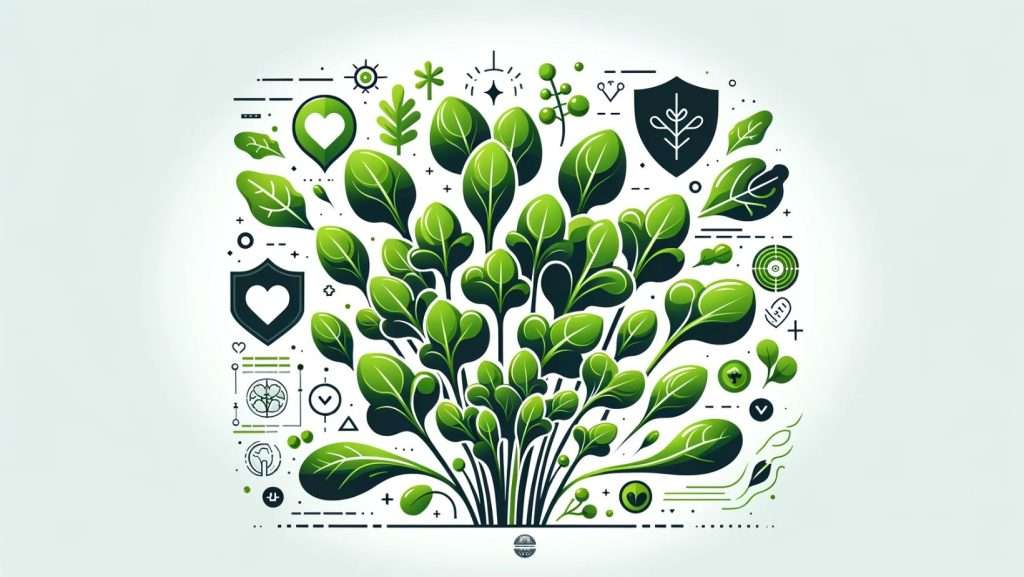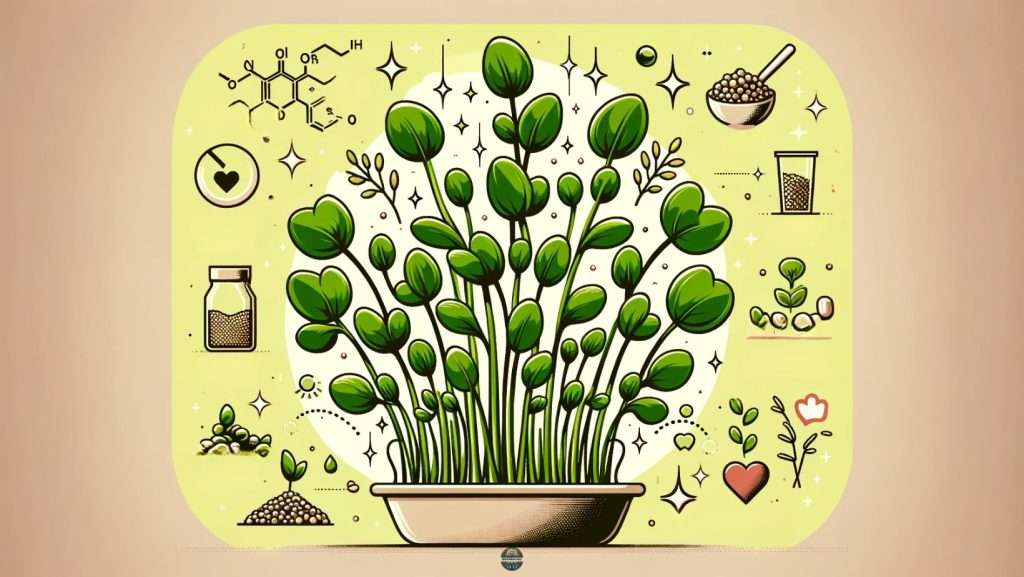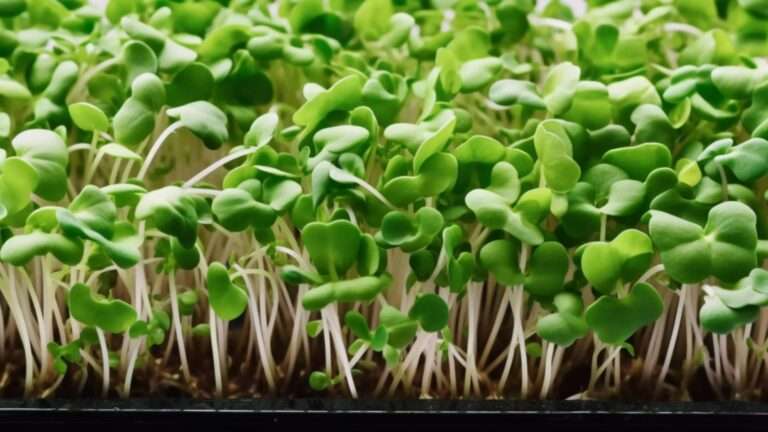Top 10 Best Tasting Microgreens: Your Comprehensive Guide to Epic Flavors
Some of our posts on Microgreensguru.com contain affiliate links. If you click on an affiliate link and make a purchase, we may receive a commission. Clicking on an affiliate link that earns a commission does NOT result in additional charges or costs you extra. Earnings from affiliate links help keep this website running. See our full affiliate disclosure here.
Microgreens are miniature versions of vegetables and herbs that pack an intense burst of flavor and nutrition. These seedlings are gaining popularity amongst home growers and chefs for their versatility in the kitchen. This article will outline the 10 best-tasting microgreens that you can easily grow at home for a flavor and nutrition boost.
What are Microgreens?
Before diving into the list, let’s clarify what microgreens actually are. Microgreens are essentially baby plants that fall somewhere between sprouts and baby leafy greens in size. They are grown in soil or soilless growing medium from vegetable, herb, or flower seeds.
Microgreens are harvested when the seedlings are young, right after the first true leaves emerge. This is typically anywhere from 7 to 21 days after germination, depending on the variety. At this young seedling stage, microgreens offer an intense concentration of nutrients, vitamins, minerals, and antioxidants.
These mighty mini greens pack a more powerful nutritional punch than their full-grown counterparts. Studies have shown that microgreens can contain up to 40 times higher levels of vital nutrients than mature greens!
So, don’t let the small size fool you — these micro powerhouses provide a mega boost of vitamins, minerals, antioxidants, and enzymes.
Key Takeaways
- Microgreens are nutrient-dense seedlings of vegetables and herbs harvested at the first true leaves stage, packing immense nutrition and bold flavors.
- Varieties like sunflower, pea shoots, arugula, and radish provide unique taste profiles from nutty and sweet to zesty and spicy flavors that enhance dishes.
- Rich in vitamins A, B-complex, C, E, and K plus protective antioxidants and minerals, microgreens provide inflammation-reducing and disease-preventing perks for optimal health.
- Extremely easy to grow at home indoors or outdoors, even with limited space. You can yield trays of microgreens in as little as 7 days for year-round freshness.
- When growing microgreens, use sterile practices, presoak certain seed varieties, maintain even moisture, allow specific seeds darkness to germinate, and harvest promptly at the seedling stage.
- Add these nutrition powerhouses to everything from salads, sandwiches, and smoothies to garnishes for soups, sides, and mains to boost flavor, texture, and nutrients in your meals.
- Let microgreens provide your gateway to flavorful gardening adventures that transform everyday dishes into culinary masterpieces bursting with visual appeal and health benefits in every bite!

Elevate Your Culinary Experience with Our Top-Tasting Microgreens Checklist
Discover the rich flavors and nutritional benefits of microgreens. These tiny greens, bigger than sprouts but smaller than baby leafy greens, offer concentrated nutrients and diverse flavors that can transform your meals. Easy to grow and delightful to taste, here are the essentials to start your microgreen journey.
Beginner’s Kit for Tasty Microgreens:
- Microgreen Starter Trays: Find the perfect size for your windowsill or garden space. [Our Favorite Microgreens Trays]
- High-Quality Soil or Hydroponic Systems: Choose from coco peat, perlite, or hydroponic grow mats for optimal growth.
- Assorted Seed Pack: Select from sunflower, pea shoots, arugula, and more for a range of flavors.
Specialty Microgreen Varieties:
- Garden Cress Seeds: For a peppery and tangy addition to your dishes. [Purchase Seeds]
- Cilantro Seeds: Add citrusy, grassy notes to your culinary creations. [Order Cilantro Seeds]
- Radish Seeds: No need for pre-soaking, simple to grow, and adds a spicy punch. [Buy Radish Seeds]
Microgreen Growing Accessories:
- Grow Lights: Ensure your microgreens thrive indoors with full-spectrum LED lights. [Check Out Our Favorite Grow Lights]
- [ ] Hydrogen Peroxide for Seed Soaking: Start with sanitized seeds to prevent mold. [Buy Hydrogen Peroxide]
Aftercare for Harvested Microgreens:
- Salad Spinner: Dry your microgreens after rinsing to extend their freshness. [Get Salad Spinner]
- Storage Containers: Keep your harvest crisp in the fridge with air-tight containers. [Purchase Our Favorite Container]
Culinary Inspiration:
- Microgreen Recipe Book: Explore new ways to enjoy microgreens in various dishes. [Our Favorite Microgreens Recipe Book]
With this checklist, you’re ready to grow and enjoy the best tasting microgreens right at home. Click through to find all you need to boost your home cooking with these nutritional powerhouses!
Benefits of Microgreens
Other than their incredible nutrition density, what makes microgreens so special? Here are some key reasons why you should add these mini superfoods into your diet:
- Bursting with nutrients: Extremely high in vitamins, minerals, antioxidants, and enzymes compared to mature greens.
- Bold flavors: Intense flavors ranging from sweet and grassy to spicy and tangy. Great way to add exciting flavors.
- Fun textures: Crispy and crunchy textures that liven up dishes.
- Beautiful garnishes: Vibrant colors to make dishes visually appealing.
- Fast growing: Many varieties are ready to harvest in under 2 weeks.
- Perfect for small spaces: Grow indoors all seasons even with limited space.
- Endless versatility: Mix and match mini greens to enhance salads, sandwiches, smoothies, and more!
Now that you know why microgreens deserve a spot in your kitchen, let’s get to the list of the 10 best-tasting microgreens that you can grow at home with ease.
Table 1. Microgreens Nutrition & Health Benefits Overview
| Microgreen Varieties | Vitamins & Antioxidants | Minerals | Health Benefits | Disease Prevention |
| Sunflower | Vitamin E, B-vitamins, Beta-carotene, Lutein | Iron, Calcium | Anti-inflammatory, Heart health | Lower cholesterol |
| Pea Shoots | Vitamin C, A, K, Folic acid, Carotenoids | Iron, Zinc | Immunity, Cell growth, Vision | Gastric cancer risk ↓ |
| Arugula | Vitamin K, C, Beta-carotene, Lutein | Calcium, Iron, Magnesium | Bone strength, Wound healing, Eye health | |
| Radish | Vitamin C, E, Anthocyanins | Calcium, Magnesium, Potassium, Phosphorus | Anti-inflammatory & antioxidant benefits | Cancer development prevention |
| Broccoli | Vitamin C, K, Sulforaphane | Manganese, Calcium, Iron | Detoxification, Bone health | Cancer cell inhibition |
1. Sunflower Microgreens

If you like nutty flavors, sunflower microgreens should top your list of greens to grow! These seedlings offer the same delightful flavor as sunflower seeds, with a nutty and earthy taste. Sunflower microgreens also have a satisfying, crunchy texture.
Flavor Profile
- Taste: Nutty and earthy flavor, similar to sunflower seeds
- Texture: Satisfying, crunchy texture
Sunflower microgreen seeds need to be pre-soaked before sowing to increase germination rates. After 7 to 14 days, the seedlings will be ready to harvest once the cotyledons (seed leaves) open up.
These versatile microgreens make a crunchy and flavorful addition:
- Salads
- Sandwiches
- Wraps
- Smoothies
- Soups
- Snacking
Sunflower microgreens also make a visually appealing garnish for various savory and sweet dishes because of their bright yellow stems and deep green leaves.

Black sunflower seeds (shell on). Sunflower seed greens are a tender baby vegetable, hi… [More]

Black sunflower seeds (shell on). Sunflower seed greens are a tender baby vegetable, hi… [More]
Nutrition & Health Benefits
Sunflower microgreens nutrition offer an array of vitamins, minerals, and healthy fats:
- High in vitamin E, which acts as an antioxidant to protect cells from damage
- Excellent source of B-complex vitamins like folate, niacin, thiamin, riboflavin and pyridoxine
- Contains the antioxidants beta-carotene and lutein
- Rich in healthy fats like omega-3 and omega-6 fatty acids
The high vitamin and antioxidant content of sunflower microgreens helps reduce inflammation and oxidative stress on a cellular level. The Omega fatty acids also promote heart health by lowering blood pressure and cholesterol levels.
Overall, the mighty sunflower microgreen should be a regular part of your diet to reap all its nutritional goodness in a bite-sized form!
2. Pea Shoots Microgreens

Sweet, crisp, and delicious pea shoot microgreens offer the taste of fresh young snow pea pods straight from the garden. These greens definitely deserve their popularity amongst growers!
Flavor Profile
- Taste: Sweet flavor like fresh young pea pods, crisp and crunchy texture
- Texture: Crispy and crunchy
To grow pea shoot microgreen seeds, it’s recommended to pre-soak them for 6 to 12 hours before planting. Presoaking speeds up germination, allowing you to enjoy the harvest sooner!
The shoots will be ready to snip off in 8 to 14 days. Add these tender pea shoot microgreens to:
- Salads
- Sandwiches
- Wraps
- Smoothies
- Soups
- Stir-fries
- Snacking
The versatile sweet flavor pairs well with most dishes!

Produces microgreens pea shoots with an abundances of curly tendrils. Tendril Peas are … [More]

Organic Yellow Pea Sprouting Seeds. Non-GMO, Heirloom. Pisum sativum. When grown as a m… [More]
Nutrition & Health Benefits
Pea shoots pack a nutritious punch, brimming with essential vitamins, minerals and antioxidants:
- Excellent source of vitamin A, C, and vitamin K
- High in folic acid (vitamin B9) which is key for cell growth and DNA formation
- Contains plant-based compounds called carotenoids that promote eye health
- Rich in fiber, protein, and omega-3 fatty acids
This unique combo of nutrients in pea shoot microgreens supports immune function, digestion, heart health, and cellular regeneration. The high antioxidant content combats inflammation to prevent cell damage over time as well.
So sprinkle these mighty pea shoot microgreens liberally onto your next meal to boost nutrition!
3. Arugula Microgreens

Do you like a good flavor kick? Then your search ends with arugula microgreens and their characteristic peppery, nutty taste.
Flavor Profile
- Taste: Peppery, earthy and nutty
- Texture: Soft and delicate
Arugula microgreen seeds are tiny, so only lightly cover them with soil after sowing. Mist gently every day to keep seeds moist until sprouts emerge.
Arugula microgreens take 10 to 14 days until the first true leaves appear for harvesting. Try these zesty greens:
- In salads
- On pizzas
- With pasta
- Sandwiches
- Wraps
The possibilities are endless when you want to add some spice! The unique flavor works well to balance sweeter ingredients too.

Red Streaked Arugula Seeds. 30 – 40 days to maturity. Eruca vesicaria sativa. Open Poll… [More]

Astro Arugula Seeds. Open pollinated, Heirloom, Non-GMO. Eruca sativa. Maturity: Approx… [More]
Nutrition & Health Benefits
These unassuming greens actually offer immense nutritional perks:
- Excellent source of vitamin K, which promotes bone health and wound healing
- High in vitamin C to support immune function and collagen formation
- Contains antioxidants like beta-carotene and lutein that protect eye health
- Rich in essential amino acids required for building proteins
So sprinkle arugula microgreens onto your next meal to reap all these nutritional benefits!
4. Radish Microgreens

If you want to add a burst of color and spicy flavor to dishes, look no further than radish microgreens! Different radish varietals produce a range of colorful seedlings with green, red, or purple foliage.
Flavor Profile
- Taste: Pleasantly spicy and peppery, similar to mature radish
- Texture: Crispy crunch
Radish seeds do not require any pre-treatment before sowing. In 7 to 15 days you’ll have vibrant little seedlings to add excitement to:
- Salads
- Sandwiches
- Tacos
- Eggs
- Pasta
- Pizza
- Soups
These micro radish seedlings make excellent garnishes too!

2 to 6 days. Arguably the most striking of the sprouting radishes. This reddish-stemmed… [More]

Certified Organic. 55 days. This popular radish for sprouting produces crisp rose color… [More]
Nutrition & Health Benefits
These petite greens offer awesome nutrition in such small packages:
- High amounts of vitamin C, an immune-boosting antioxidant
- Excellent source of vitamin E, a powerful antioxidant
- Rich in vitamin K, vitamin B6, magnesium and potassium
- Contains protective antioxidants like anthocyanins
The phytonutrients in radish microgreens help fight oxidative damage from free radicals, reducing inflammation at the cellular level. This is key to preventing chronic diseases over time.
Table 2. Microgreens Flavor Profile Details
| Microgreen Varieties | Flavor Taste Notes | Aroma | Best Paired With | Texture |
| Sunflower | Nutty, earthy, sweet | Nutty | Salads, sandwiches, eggs, chicken, fruit | Crispy, tender crunch |
| Pea Shoots | Sweet pea pod, grassy | Fresh, green | Salads, stir fries, rice bowls, eggs | Velvety, juicy crunch |
| Arugula | Peppery, pungent, bitter | Herbaceous, green | Pesto, pizza, pasta, potatoes | Soft, delicate |
| Radish | Spicy, peppery, pungent | Earthy, green | Salads, slaws, tacos, bloody marys | Crisp, juicy crunch |
| Basil | Sweet, floral, minty | Fragrant | Pastas, pizzas, dressings, cocktails | Soft, delicate |
5. Basil Microgreens

For a touch of herby goodness, basil should be on your microgreen grow list! The seedlings carry that sweet, aromatic flavor so characteristic of the full-grown herb.
Flavor Profile
- Taste: Sweet aroma, floral flavor
- Texture: Soft and delicate
Basil seeds are very small and sticky, so just lightly press them into your soil and keep the planting tray out of direct sunlight until sprouts emerge.
In 3 to 4 weeks, tiny basil leaves will be ready to enliven:
- Pastas
- Pizzas
- Pesto
- Salads
- Sandwiches
- Wraps
- Smoothies
- Dressings and dips
Basil microgreens also make lovely garnishes for their vivid green color. Try them on soups, savory bakes and even cocktails!

Ocimum basilicum Annual. An intensely scented strain of sweet basil with slightly hair… [More]

This world famous herb takes to 75 days to fully mature. Basil was very common to the o… [More]

This fragrant basil strain takes up to 60 days to reach maturity. Compact growing habit… [More]
Nutrition & Health Benefits
Don’t underestimate these fragrant greens – they come packed with goodness:
- High in vitamin K, which promotes bone and heart health
- Excellent source of vitamin A to maintain healthy vision, skin and mucous membranes
- Contains antioxidants like carotenoids to combat oxidative damage by free radicals
- Provides anti-inflammatory benefits
So sprinkle these petite basil leaves onto your dishes not just for flavor but also for fantastic nutrition.
6. Cilantro Microgreens

Cilantro microgreens delight the palate with grassy, citrusy notes reminiscent of the mature herb leaves. Their delicate texture and flavor are quite versatile in the kitchen.
Flavor Profile
- Taste: Citrusy, grassy
- Texture: Delicate, feather-like foliage
Cilantro microgreen seeds germinate best when pre-soaked before planting. Gently water until sprouts emerge after 5-10 days.
Snip off the maturing foliage after 2-3 weeks to add zesty flavor to:
- Salsas
- Chutneys
- Curries
- Salads
- Sandwiches
- Wraps
- Tacos
- Stir-fries
Cilantro microgreens also make a lovely fresh garnish with their frilly green leaves.

Organic. Non-GMO. Coriandrum sativum. Cilantro seed is actually a dried ripe fruit. Lei… [More]

This strain of cilantro ingrown primarily for its broad, deep green, celery-like, punge… [More]
Nutrition & Health Benefits
Like the mature herb, cilantro microgreens provide a mega boost of vitamins and protective plant compounds:
- Excellent source of immune-boosting vitamins C, A, and vitamin K
- Contains various antioxidants to combat inflammation and cell damage by free radicals
- Rich in phytonutrients that support detoxification
So, sprinkle these powerful cilantro microgreens onto dishes for both intense flavor as well as nutrition.
7. Beet Microgreens

If you want to add delightful pops of color and earthy flavor to dishes, beet microgreens fit the bill with their vibrant red stems and deep green leaves.
Flavor Profile
- Taste: Earthy and sweet, similar to beets
- Texture: Crisp crunch
For best germination rates, soak beet microgreen seeds overnight before planting. Expect sprouts to emerge in 7 to 14 days.
Snip off the young beet seedlings in 10 to 21 days to use:
- In salads
- With cheese platters
- On avocado toast
- In sandwiches
- With eggs
- Juices and smoothies
The red stems provide a beautiful contrast sprinkled over greens or grains. The mild earthy flavor also complements both sweet and savory dishes.

60 days. This mix of Detroit Red and Golden beets will make for a colorful and tasty ha… [More]

35 days until tops are mature and 55 days for roots. An older cultivar known for its sw… [More]
Nutrition & Health Benefits
Besides visual appeal, beet microgreens also provide immense nutritional value:
- Excellent source of vitamin C, vitamin E, and vitamin K
- Contains protective antioxidants called betalains
- Rich in vital minerals like iron, calcium, magnesium, and potassium
The betalains found in beet microgreens display potent anti-inflammatory, antiviral, and anti-carcinogenic properties. These bioactive compounds support cellular health to combat chronic diseases over time.
8. Broccoli Microgreens

Looking for an easy yet mighty green to grow? Broccoli microgreens are mild-tasting, nutrient-packed seedlings perfect for beginners.
Flavor Profile
- Taste: Subtle earthy and grassy flavor
- Texture: Tender crunch
Broccoli microgreen seeds do not require any pre-treatment before planting. Expect sprouts to pop out of the soil in just 2 to 5 days.
Harvest the seedlings after 7 to 14 days to add to:
- Salads
- Soups
- Sandwiches
- Omelets
- Casseroles
- Smoothies
The mild flavor works well in most dishes without overpowering.

45 days. Organic. Actually a relative to turnips but the flowering heads are similar in… [More]

Certified Organic by Oregon Tilth. Start Green Sprouting broccoli early in the season a… [More]
Nutrition & Health Benefits
These petite seedlings offer immense nutritional benefits:
- Rich in vitamin C, an antioxidant that boosts immunity
- Excellent source of vitamin K for healthy bones
- Contains high levels of antioxidant sulforaphane to combat chronic inflammation
- Rich in iron, manganese, magnesium and phosphorus
What makes broccoli microgreens special is their very high concentration of cancer-fighting compounds called glucosinolates compared to mature broccoli. Studies show that these nutrients help detox enzymes in the body, preventing various cancers.
So add these disease-fighting broccoli microgreens to your regular diet!
9. Mustard Microgreens

If you love spicy flavors, mustard microgreens should be high on your grow list for their intense zing. The seedlings look almost like miniature mustard greens with their frilly foliage.
Flavor Profile
- Taste: Strong spicy flavor, similar to mustard greens or mustard condiment
- Texture: Delicate and crisp
Mustard microgreens prefer cooler temperatures. After seeds are sown, mist gently daily until sprouts emerge in 4 to 6 days.
Harvest the delicate seedlings in 8 to 14 days to spice up:
- Salads
- Sandwiches
- Eggs
- Pasta
- Pizza
- Stir-fries
Mustard microgreen varieties like purple Osaka and red mustard also make vivid garnishes. The color contrast looks fantastic against lighter dishes!

21 to 45 days. An outstanding mustard of dark green-purple leaves with bright white ve… [More]

45 days. This mustard has large green leaves with wavy edges and a fun wasabi-like bit… [More]

Brown mustard seeds are traditionally used to add spice to cooking. When sprouted the s… [More]

A great mustard for microgreens, this has a rather sharp flavor that brings a great zin… [More]
Nutrition & Health Benefits
These micro mustard seedlings offer immense nutritional benefits too:
- Rich in vitamin K, a blood-clotting nutrient
- Excellent source of immune-strengthening vitamin C
- High in vitamin E, an antioxidant that protects cells
- Contains protective glucosinolates to prevent cancer development
- Rich in minerals like manganese, copper, and calcium
So spice up your next dish with these nutritionally loaded mustard microgreens!
10. Garden Cress Microgreens

Last but certainly not least are garden cress microgreens. Their flavor can be described as peppery with a hint of tangy, lemon notes.
Flavor Profile
- Taste: Peppery, tangy
- Texture: Feathery and crisp
Garden cress microgreen seeds need light to germinate so do not cover with soil after planting. Expect sprouts in just 2 to 4 days.
Snip off the delicate seedlings after 8 to 14 days to add to:
- Salads
- Sandwiches
- Rice paper rolls
- Eggs
- Potato dishes
- Smoothies
Garden cress makes an awesome flavor boost and vivid garnish for its bright green color.

Annual. Also called Garden Cress or Peppergrass. Ruffled leaves have a peppery and refr… [More]
Nutrition & Health Benefits
These microgreens definitely pack a punch when it comes to nutrition:
- Very high in immune-strengthening vitamin C
- Excellent source of vitamin A to maintain healthy skin and vision
- Contains vitamin E, vitamin B1, iron, and calcium
- Rich in eye-protecting carotenoids like beta carotene
So sprinkle these nutritional cress microgreens onto your next dish for both tangy flavor and fantastic health perks!
Growing Guidelines To Get the Best Tasting Microgreens
Now that you know the 10 tastiest microgreens to grow, let’s go over some key growing guidelines to set you up for success:
- Choose Your Grow Zone: Where should you grow microgreens? You can cultivate microgreens both indoors or outdoors pretty successfully. Just choose the space with ample sunlight – a minimum of 5 hours daily. South-facing windowsills are perfect indoor spots.
- Select Your Grow Medium: You can use sterile potting mix, cocopeat, perlite or even grow mats as microgreen mediums. Make sure you provide good drainage and moisture retention.
- Use Shallow Grow Trays: Sow seeds in sterile, shallow trays roughly 2 to 3 inches deep. This allows young roots to access both moisture and oxygen easily. Any large tray with drainage holes works well.
- Soak & Sanitize Seeds: Certain seeds like basil, cilantro, and sunflowers need soaking before planting to increase germination rates. A 30-minute 1% hydrogen peroxide soak also helps prevent mold growth.
- Sow Seeds Densely: Microgreens grow best when tightly spaced 1 to 2 inches apart to remain upright with minimal legginess. But don’t overcrowd too densely or air circulation will be impacted.
- Control Light & Temperature: Some seeds require darkness to germinate – like basil, broccoli, and peas. Other greens prefer light as soon as they’re planted. Ideal temps range from 65-75°F for most varieties.
- Maintain Moisture: Water soil lightly daily, taking care not to oversaturate it. Use a spray bottle to gently mist the soil as needed to keep it evenly moist. For mature microgreens ready for harvesting, begin bottom-watering instead to prevent damage to stems and foliage.
- Harvest at Seedling Stage: Knowing the best time to harvest microgreens is key! Look for the emergence of the first true leaves which occurs in 7-21 days typically. Use clean scissors for harvesting stems just above the soil level.
- Rinse & Store Properly: Gently rinse harvested microgreens before storage. Pat dry thoroughly with a salad spinner or soft towel. Store semi-dry greens in air-tight containers in the fridge for 5 to 7 days maximum.
Table 3. Microgreens Cultivation Cheat Sheet
| Microgreen Varieties | Time to Harvest | Germination Needs | Pre-Treatment | Temperatures |
| Sunflower | 7-14 days | Light | Soak 6-24 hrs | 65-75°F |
| Pea Shoots | 10-14 days | Darkness | Soak 6-12 hrs | 60-75°F |
| Arugula | 10-14 days | Light | None | 60-70°F |
| Radish | 8-12 days | Light | None | 60-70°F |
| Broccoli | 7-14 days | Darkness | None | 65-85°F |
| Basil | 21-28 days | Darkness | Soak briefly | 65-75°F |
Microgreen Growing Tips
Here are some additional growing tips to help ensure success:
- Sterilize all equipment and use sterile mediums to prevent mold growth
- Bottom-water mature microgreens to prevent soil splash and stem damage
- Grow different microgreen varieties together for added diversity, color, and nutrition
- Control humidity levels between 40-60% to prevent excessive moisture and fungal diseases
- Ventilate growing area while also blocking intense wind or drafts
- Check microgreens daily and troubleshoot issues immediately
- Record seeding dates to optimize growing practices and determine ideal harvest times for each variety
- Start with versatile beginner-friendly varieties like sunflowers, peas and radishes
Final Thoughts
Microgreens are nutritional powerhouses packed with intense flavors that can transform ordinary meals. These miniature seedlings of vegetables and herbs contain up to 40x higher concentrations of vitamins, minerals, and antioxidants compared to their full-grown counterparts.
As outlined in this article, microgreens like sunflower, pea shoots, arugula, radish, and basil provide unique flavor profiles ranging from sweet and nutty to tangy and peppery. Their vibrant colors and textures also enhance the appearance of dishes. Additionally, different microgreen varieties offer specific health benefits from reducing inflammation to protecting eye health and beyond.
Cultivating microgreens at home is an easy gardening project even with limited space. Key growing guidelines include using sterile equipment, controlling light and humidity, maintaining even moisture, and harvesting at the seedling stage. Proper post-harvest storage also preserves microgreen freshness and quality.
With minimal effort, home growers can enjoy trays of flavorful, nutrient-dense microgreens year-round. Transform salads, sandwiches, smoothies, and garnishes with these mighty greens. Let microgreens provide your gateway to flavorful, fun gardening adventures that boost nutrition in every bite!
Frequently Asked Questions the Best Tasting Microgreens

Cal Hewitt is the Founder and Lead Cultivator at Microgreens Guru, a website dedicated to empowering individuals to grow, consume, and potentially sell nutrient-dense microgreens. With 5 years of hands-on experience in microgreens cultivation, Cal brings a unique analytical perspective to the world of urban agriculture. He specializes in optimizing growth techniques for various microgreen varieties, while also focusing on sustainable and cost-effective growing methods. Cal’s passion for microgreens, ignited by a personal health journey, drives him to continuously explore and share innovative approaches to microgreens cultivation. His practical experience, combined with his commitment to education through his website and upcoming book, ensures that Microgreens Guru remains a valuable resource for both novice and experienced growers alike.







